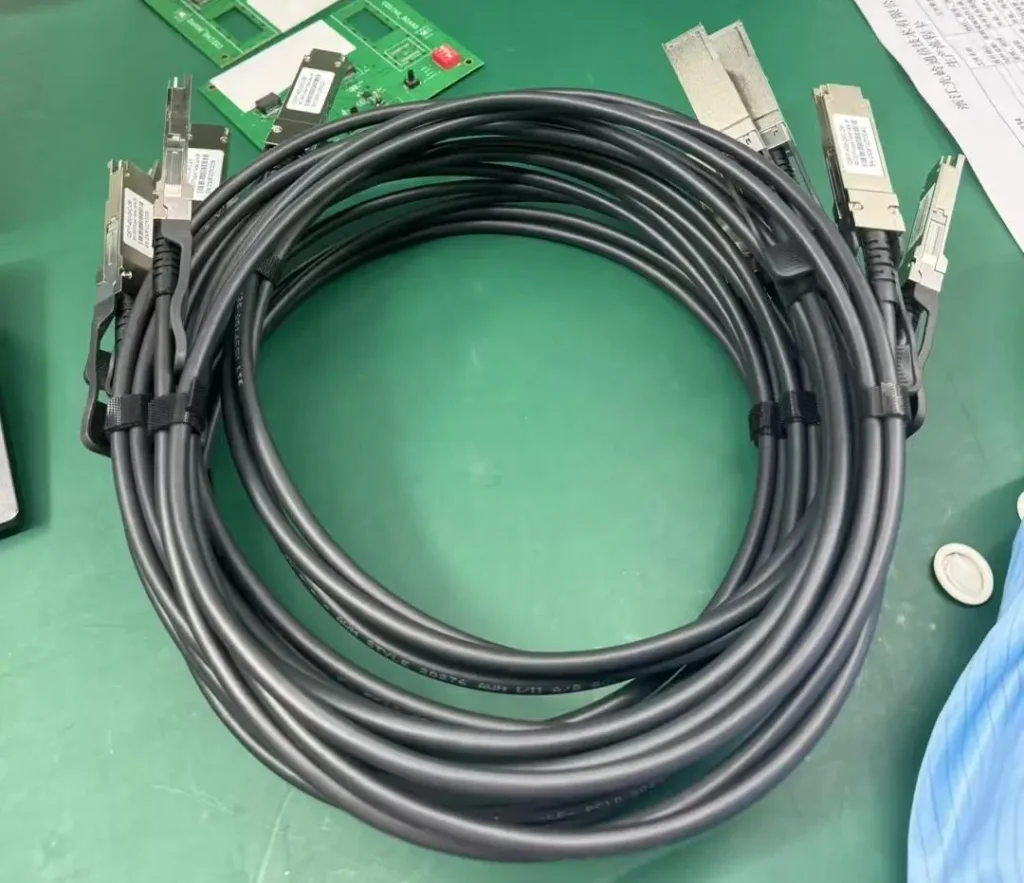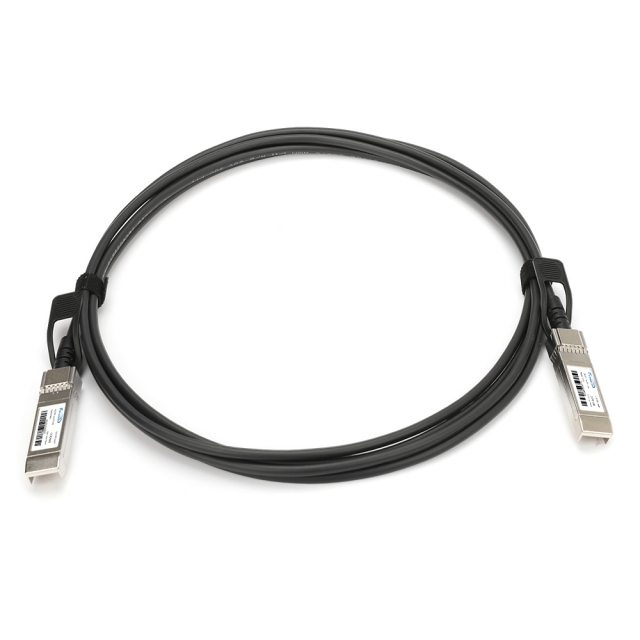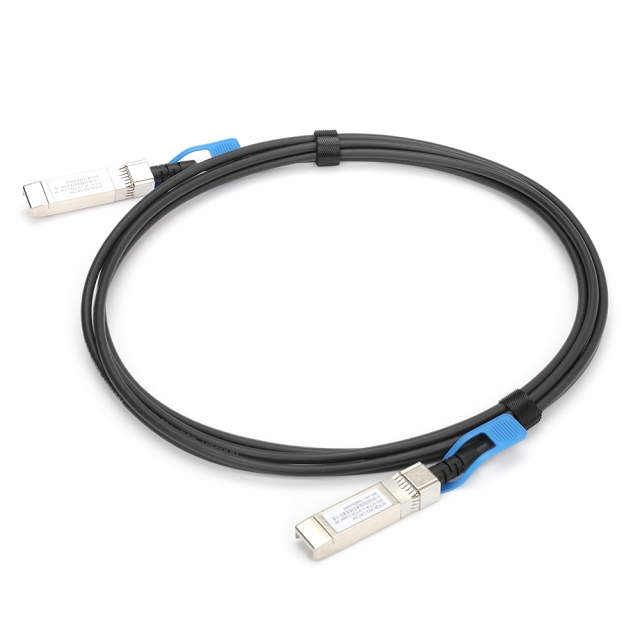Common Categories and Models of Direct Attached Cables
Direct Attach Cables (DACs) are the simplest, most cost-effective short-reach links inside modern data centers. They deliver high bandwidth, low latency, and great density for top-of-rack (ToR), server-to-switch and switch-to-switch connections. This article summarizes the common DAC categories and models you’ll encounter today — including standard and breakout DACs — and gives clear guidance for choosing the right type for your deployment.
What is a DAC Cable?
A Direct Attach Cable is a factory-terminated, fixed-length cable assembly with module-style connectors on both ends (SFP/SFP+, SFP28, QSFP/QSFP+, QSFP28, QSFP56, QSFP-DD, OSFP, etc.). There are two main physical implementations:
Passive DAC: Twinax copper cable with no active electronics. Very low cost and power; ideal for very short runs inside racks.
Active DAC (ACC or Active Twinax): Includes signal conditioning components (equalizers, retimers) to extend reach and support higher speeds with reliable signal integrity.

Active vs. Passive — quick comparison
Passive: lowest cost, near-zero power, limited reach (typically fractions of a meter to several meters).
Active: higher cost and small power draw, but extended reach and better support for high-speed PAM-4 links and next-gen form factors.
Common DAC categories and models (organized by speed & form factor)
10G SFP+
SFP+ ↔ SFP+ (10G DAC) — classic server-to-switch jumper. Passive for in-rack use; active when extra reach or signal conditioning is required.
25G SFP28
SFP28 ↔ SFP28 (25G DAC) — modern server NICs and ToR links commonly use SFP28 for 25GbE. Available passive and active.
40G QSFP+
QSFP+ ↔ QSFP+ (40G DAC) — single 40GbE link for aggregation and leaf/spine short links.
40G QSFP+ → 4× SFP+ Breakout DAC — one QSFP+ port broken out to four 10G SFP+ ports. Widely used to split uplinks economically (e.g., one 40G switch port to four 10G servers).
100G QSFP28
QSFP28 ↔ QSFP28 (100G DAC) — native 100GbE using 4×25G lanes; common between switches or between a 100G NIC and a switch.
100G QSFP28 → 4× SFP28 Breakout DAC — converts one 100G port into four independent 25G ports for server aggregation or storage connectivity.
200G QSFP56
QSFP56 ↔ QSFP56 (200G DAC) — used for higher aggregate links in modern fabrics.
200G QSFP56 → 2×100G QSFP56 Breakout DAC — splits one 200G port into two 100G links when port topology or NICs require half-rate connections.
400G
QSFP-DD / QSFP112 ↔ same (400G DAC/ACC) — high-density 400GbE switch interconnects; many implementations use PAM4 signaling and active components.
400G OSFP → 2×200G OSFP Breakout DAC — splits a single 400G OSFP port into two independent 200G OSFP links for flexible fabric design and multi-rate deployments.
Note: This article omits 50G and 56G classes per your instruction; the focus is on the commonly deployed speeds above.
Breakout DACs — why and when to use them
Breakout DACs physically redistribute the underlying electrical lanes from a high-speed port into multiple lower-speed ports (for example, 1×100G → 4×25G, or 1×400G → 2×200G). Use cases:
Server aggregation when servers have multiple 25G/100G NICs.
Cost-effective port consolidation on switches.
Gradual upgrade paths where some servers remain at lower speeds.
Key point: breakout DACs don’t increase total bandwidth — they reassign lanes into smaller channels.
Practical reach, latency and power
Reach: Passive DACs typically cover very short distances (sub-meter to a few meters). Active DACs extend ranges (often up to ~10–15 m depending on gauge and design) and are essential for many 200G+ PAM4 links. Always check manufacturer specs for rated lengths.
Latency: DACs are extremely low-latency compared with optical transceivers + fiber.
Power: Passive DACs consume negligible power; active DACs draw modest power for signal conditioning but usually less than optical transceivers.
How to choose the right DAC Cables
Match form factor and port compatibility: Verify both endpoints support the same module type and breakout behavior.
Pick active vs passive by reach and speed: For ultra-short runs and lowest cost use passive; for longer short runs or higher speeds choose active.
Confirm vendor compatibility: Some platforms restrict third-party DACs. Check vendor compatibility lists or use vendor-approved parts.
Consider cable gauge and length: Lower AWG (thicker) cables reduce loss and may support slightly longer distances.
Plan breakout strategy: Ensure the switch/NIC supports the breakout mapping you require (e.g., 1×400G → 2×200G).
FAQ
Generally no — DACs are optimized for in-rack or adjacent-rack links. Use fiber or AOC for longer distances.
No — a breakout cable is designed for specific port mappings and cannot be arbitrarily re-aggregated.
Many 200G+ and 400G implementations require active conditioning, but always consult the part spec.
Conclusion
DACs remain essential for high-density, low-latency, cost-sensitive short-reach interconnects. From simple 10G SFP+ jumpers to advanced 400G OSFP breakouts, choose the right form factor, decide between active or passive depending on reach and speed, and ensure platform compatibility. If you’d like, I can convert this into a Fibrecross product page, a short procurement checklist, or an SEO-optimized blog post targeted at your customers — tell me which format you prefer.





